Advanced Financial Accounting: Corporate Bankruptcy Analysis Report
VerifiedAdded on 2021/05/30
|11
|2831
|123
Report
AI Summary
This report provides an in-depth analysis of corporate bankruptcies, focusing on the underlying causes and offering recommendations for prevention. It begins with an executive summary highlighting the rise in corporate liquidations, attributing these failures to factors like excessive liabilities and flawed management strategies. The report critically examines three major bankruptcy cases in Australia: ABC Learning, HIH Insurance, and One Tel. Through detailed case studies, it identifies common themes such as faulty management strategies, irregularities in financial reporting, and compromised corporate governance. The analysis reveals that while high liabilities are often the immediate cause, the core issues stem from poor decision-making and a focus on maximizing management incentives. The report offers recommendations for ensuring accountability and improving corporate governance to prevent similar instances in the future. The report emphasizes the importance of robust risk management, transparent financial reporting, and adherence to ethical business practices. The study concludes by underscoring the need for proactive measures to maintain investor confidence and promote sustainable business practices.
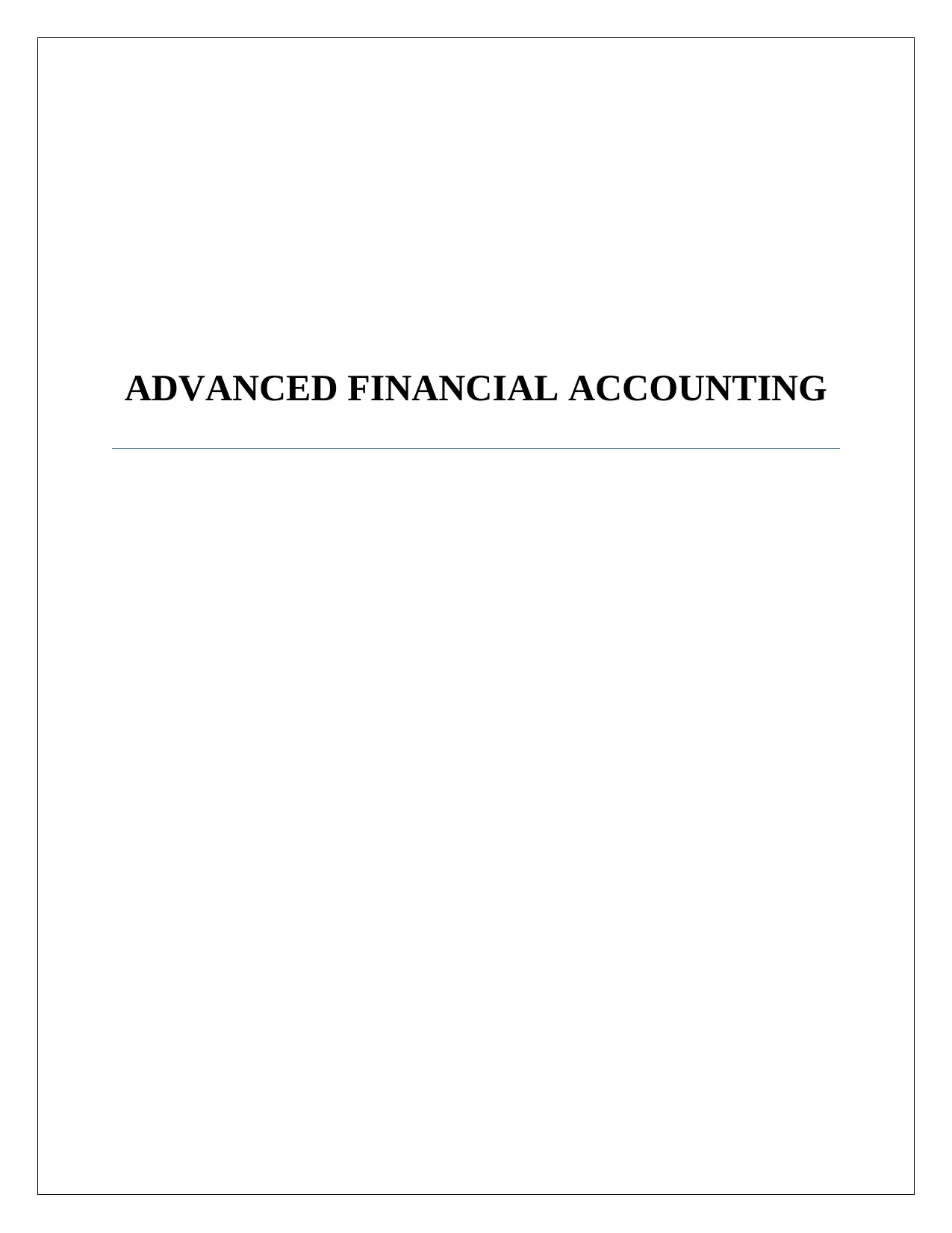
ADVANCED FINANCIAL ACCOUNTING
Paraphrase This Document
Need a fresh take? Get an instant paraphrase of this document with our AI Paraphraser
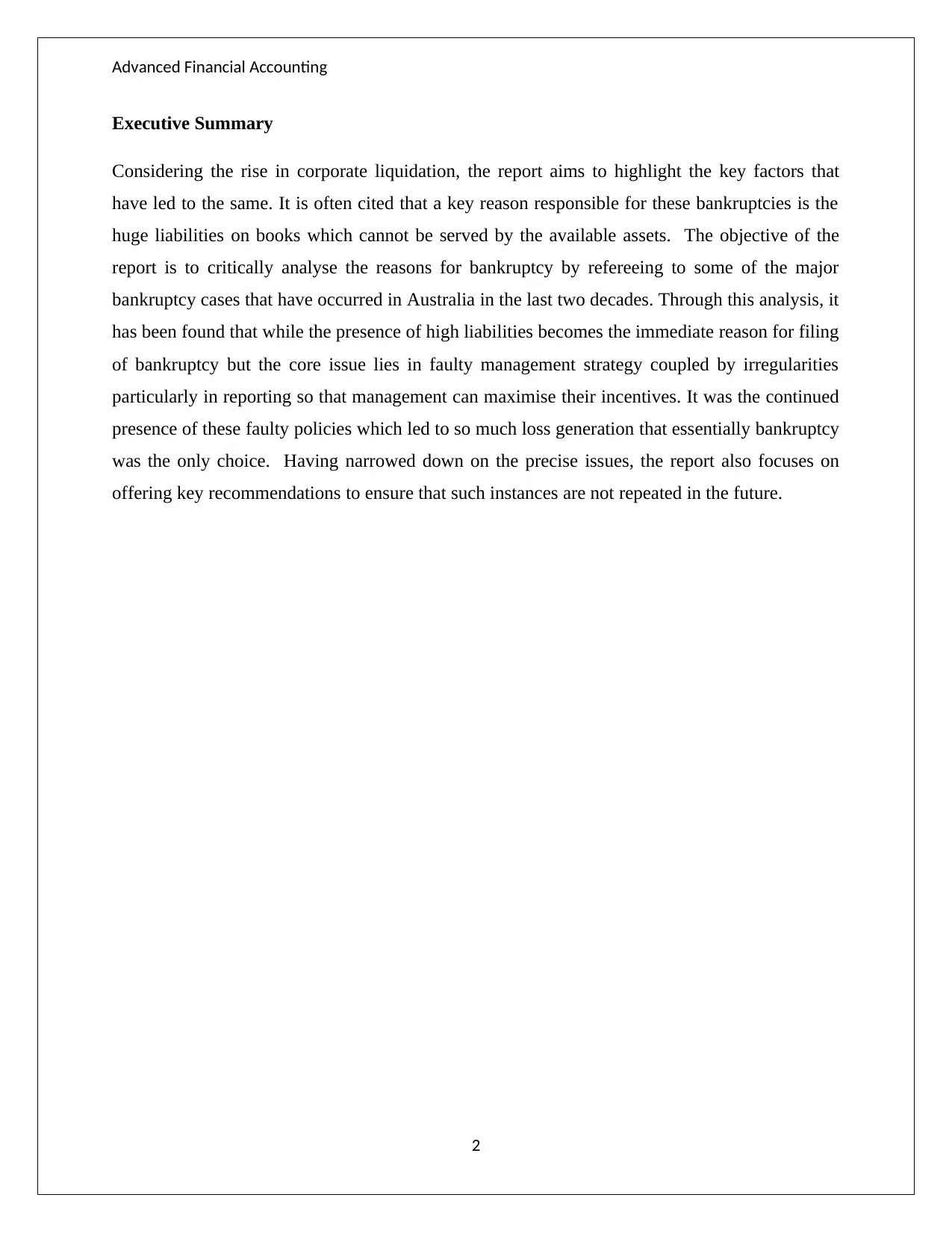
Advanced Financial Accounting
Executive Summary
Considering the rise in corporate liquidation, the report aims to highlight the key factors that
have led to the same. It is often cited that a key reason responsible for these bankruptcies is the
huge liabilities on books which cannot be served by the available assets. The objective of the
report is to critically analyse the reasons for bankruptcy by refereeing to some of the major
bankruptcy cases that have occurred in Australia in the last two decades. Through this analysis, it
has been found that while the presence of high liabilities becomes the immediate reason for filing
of bankruptcy but the core issue lies in faulty management strategy coupled by irregularities
particularly in reporting so that management can maximise their incentives. It was the continued
presence of these faulty policies which led to so much loss generation that essentially bankruptcy
was the only choice. Having narrowed down on the precise issues, the report also focuses on
offering key recommendations to ensure that such instances are not repeated in the future.
2
Executive Summary
Considering the rise in corporate liquidation, the report aims to highlight the key factors that
have led to the same. It is often cited that a key reason responsible for these bankruptcies is the
huge liabilities on books which cannot be served by the available assets. The objective of the
report is to critically analyse the reasons for bankruptcy by refereeing to some of the major
bankruptcy cases that have occurred in Australia in the last two decades. Through this analysis, it
has been found that while the presence of high liabilities becomes the immediate reason for filing
of bankruptcy but the core issue lies in faulty management strategy coupled by irregularities
particularly in reporting so that management can maximise their incentives. It was the continued
presence of these faulty policies which led to so much loss generation that essentially bankruptcy
was the only choice. Having narrowed down on the precise issues, the report also focuses on
offering key recommendations to ensure that such instances are not repeated in the future.
2
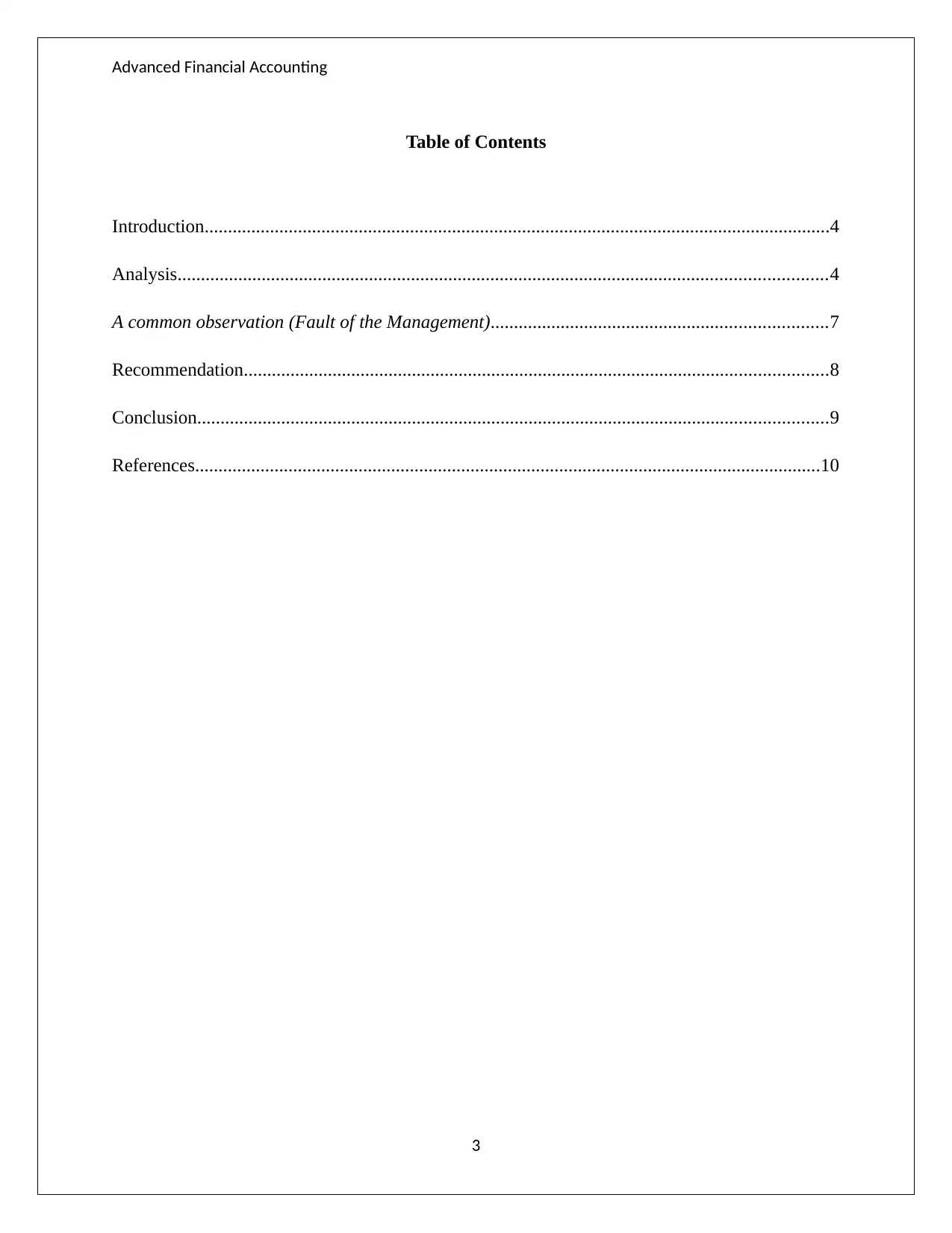
Advanced Financial Accounting
Table of Contents
Introduction......................................................................................................................................4
Analysis...........................................................................................................................................4
A common observation (Fault of the Management)........................................................................7
Recommendation.............................................................................................................................8
Conclusion.......................................................................................................................................9
References......................................................................................................................................10
3
Table of Contents
Introduction......................................................................................................................................4
Analysis...........................................................................................................................................4
A common observation (Fault of the Management)........................................................................7
Recommendation.............................................................................................................................8
Conclusion.......................................................................................................................................9
References......................................................................................................................................10
3
⊘ This is a preview!⊘
Do you want full access?
Subscribe today to unlock all pages.

Trusted by 1+ million students worldwide
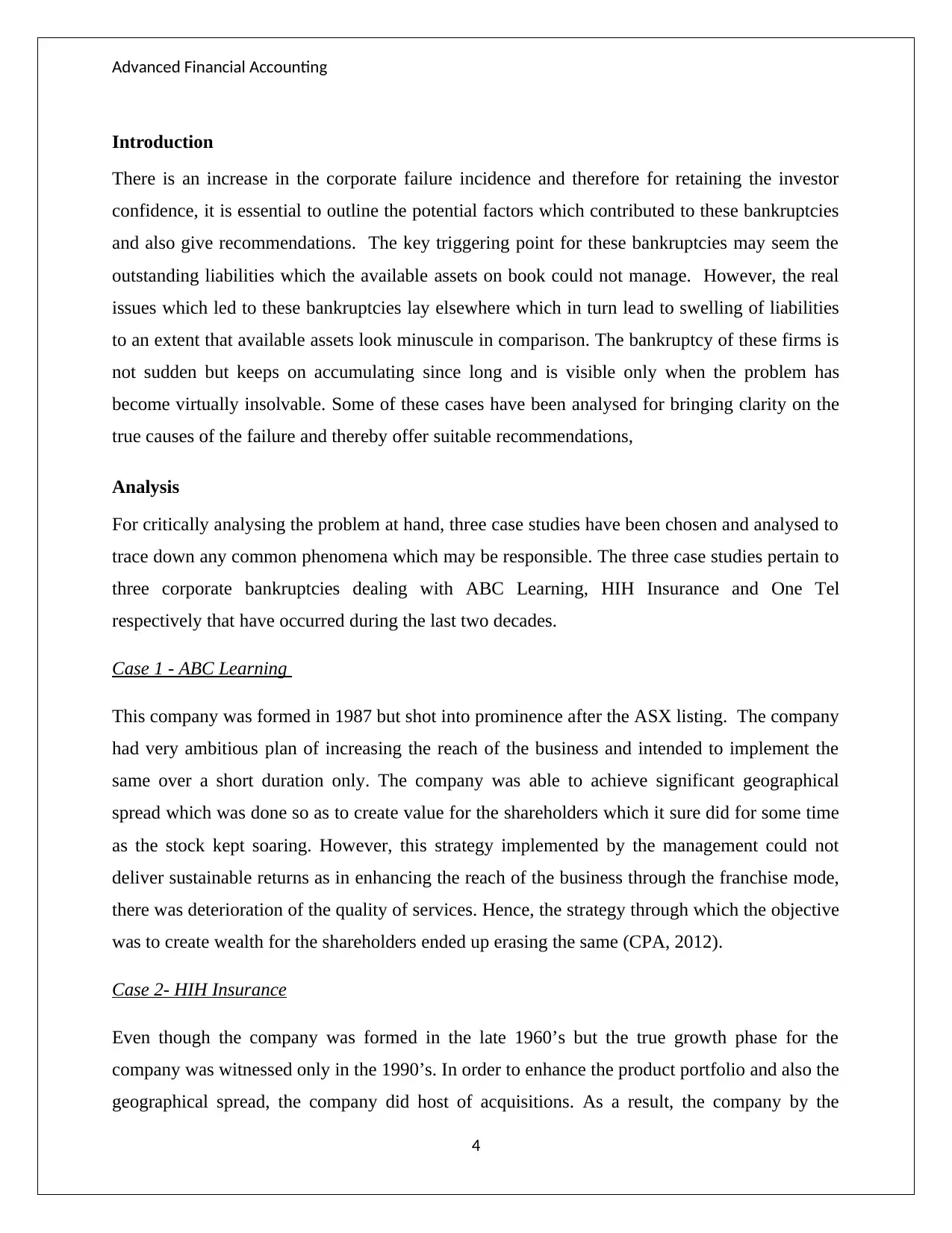
Advanced Financial Accounting
Introduction
There is an increase in the corporate failure incidence and therefore for retaining the investor
confidence, it is essential to outline the potential factors which contributed to these bankruptcies
and also give recommendations. The key triggering point for these bankruptcies may seem the
outstanding liabilities which the available assets on book could not manage. However, the real
issues which led to these bankruptcies lay elsewhere which in turn lead to swelling of liabilities
to an extent that available assets look minuscule in comparison. The bankruptcy of these firms is
not sudden but keeps on accumulating since long and is visible only when the problem has
become virtually insolvable. Some of these cases have been analysed for bringing clarity on the
true causes of the failure and thereby offer suitable recommendations,
Analysis
For critically analysing the problem at hand, three case studies have been chosen and analysed to
trace down any common phenomena which may be responsible. The three case studies pertain to
three corporate bankruptcies dealing with ABC Learning, HIH Insurance and One Tel
respectively that have occurred during the last two decades.
Case 1 - ABC Learning
This company was formed in 1987 but shot into prominence after the ASX listing. The company
had very ambitious plan of increasing the reach of the business and intended to implement the
same over a short duration only. The company was able to achieve significant geographical
spread which was done so as to create value for the shareholders which it sure did for some time
as the stock kept soaring. However, this strategy implemented by the management could not
deliver sustainable returns as in enhancing the reach of the business through the franchise mode,
there was deterioration of the quality of services. Hence, the strategy through which the objective
was to create wealth for the shareholders ended up erasing the same (CPA, 2012).
Case 2- HIH Insurance
Even though the company was formed in the late 1960’s but the true growth phase for the
company was witnessed only in the 1990’s. In order to enhance the product portfolio and also the
geographical spread, the company did host of acquisitions. As a result, the company by the
4
Introduction
There is an increase in the corporate failure incidence and therefore for retaining the investor
confidence, it is essential to outline the potential factors which contributed to these bankruptcies
and also give recommendations. The key triggering point for these bankruptcies may seem the
outstanding liabilities which the available assets on book could not manage. However, the real
issues which led to these bankruptcies lay elsewhere which in turn lead to swelling of liabilities
to an extent that available assets look minuscule in comparison. The bankruptcy of these firms is
not sudden but keeps on accumulating since long and is visible only when the problem has
become virtually insolvable. Some of these cases have been analysed for bringing clarity on the
true causes of the failure and thereby offer suitable recommendations,
Analysis
For critically analysing the problem at hand, three case studies have been chosen and analysed to
trace down any common phenomena which may be responsible. The three case studies pertain to
three corporate bankruptcies dealing with ABC Learning, HIH Insurance and One Tel
respectively that have occurred during the last two decades.
Case 1 - ABC Learning
This company was formed in 1987 but shot into prominence after the ASX listing. The company
had very ambitious plan of increasing the reach of the business and intended to implement the
same over a short duration only. The company was able to achieve significant geographical
spread which was done so as to create value for the shareholders which it sure did for some time
as the stock kept soaring. However, this strategy implemented by the management could not
deliver sustainable returns as in enhancing the reach of the business through the franchise mode,
there was deterioration of the quality of services. Hence, the strategy through which the objective
was to create wealth for the shareholders ended up erasing the same (CPA, 2012).
Case 2- HIH Insurance
Even though the company was formed in the late 1960’s but the true growth phase for the
company was witnessed only in the 1990’s. In order to enhance the product portfolio and also the
geographical spread, the company did host of acquisitions. As a result, the company by the
4
Paraphrase This Document
Need a fresh take? Get an instant paraphrase of this document with our AI Paraphraser
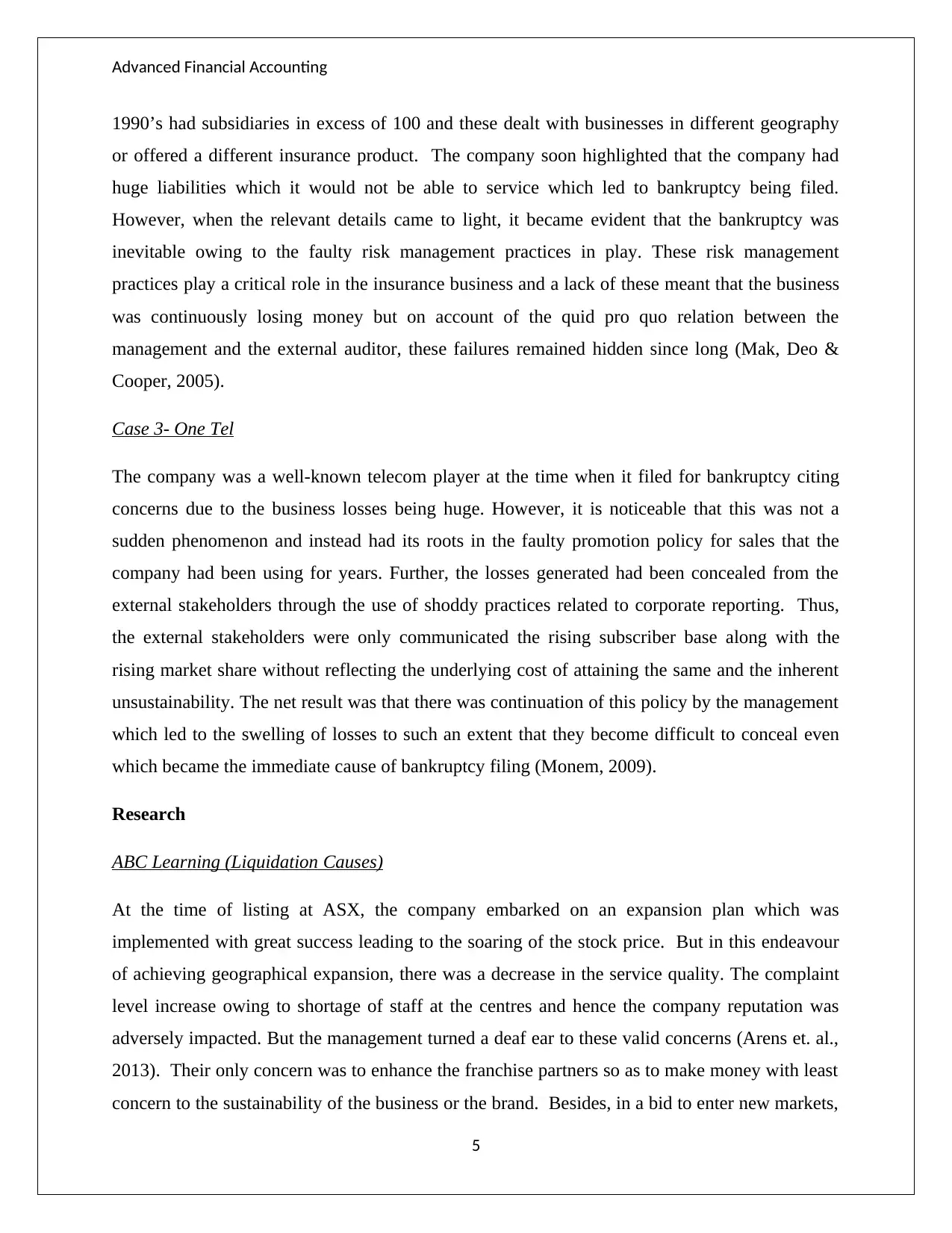
Advanced Financial Accounting
1990’s had subsidiaries in excess of 100 and these dealt with businesses in different geography
or offered a different insurance product. The company soon highlighted that the company had
huge liabilities which it would not be able to service which led to bankruptcy being filed.
However, when the relevant details came to light, it became evident that the bankruptcy was
inevitable owing to the faulty risk management practices in play. These risk management
practices play a critical role in the insurance business and a lack of these meant that the business
was continuously losing money but on account of the quid pro quo relation between the
management and the external auditor, these failures remained hidden since long (Mak, Deo &
Cooper, 2005).
Case 3- One Tel
The company was a well-known telecom player at the time when it filed for bankruptcy citing
concerns due to the business losses being huge. However, it is noticeable that this was not a
sudden phenomenon and instead had its roots in the faulty promotion policy for sales that the
company had been using for years. Further, the losses generated had been concealed from the
external stakeholders through the use of shoddy practices related to corporate reporting. Thus,
the external stakeholders were only communicated the rising subscriber base along with the
rising market share without reflecting the underlying cost of attaining the same and the inherent
unsustainability. The net result was that there was continuation of this policy by the management
which led to the swelling of losses to such an extent that they become difficult to conceal even
which became the immediate cause of bankruptcy filing (Monem, 2009).
Research
ABC Learning (Liquidation Causes)
At the time of listing at ASX, the company embarked on an expansion plan which was
implemented with great success leading to the soaring of the stock price. But in this endeavour
of achieving geographical expansion, there was a decrease in the service quality. The complaint
level increase owing to shortage of staff at the centres and hence the company reputation was
adversely impacted. But the management turned a deaf ear to these valid concerns (Arens et. al.,
2013). Their only concern was to enhance the franchise partners so as to make money with least
concern to the sustainability of the business or the brand. Besides, in a bid to enter new markets,
5
1990’s had subsidiaries in excess of 100 and these dealt with businesses in different geography
or offered a different insurance product. The company soon highlighted that the company had
huge liabilities which it would not be able to service which led to bankruptcy being filed.
However, when the relevant details came to light, it became evident that the bankruptcy was
inevitable owing to the faulty risk management practices in play. These risk management
practices play a critical role in the insurance business and a lack of these meant that the business
was continuously losing money but on account of the quid pro quo relation between the
management and the external auditor, these failures remained hidden since long (Mak, Deo &
Cooper, 2005).
Case 3- One Tel
The company was a well-known telecom player at the time when it filed for bankruptcy citing
concerns due to the business losses being huge. However, it is noticeable that this was not a
sudden phenomenon and instead had its roots in the faulty promotion policy for sales that the
company had been using for years. Further, the losses generated had been concealed from the
external stakeholders through the use of shoddy practices related to corporate reporting. Thus,
the external stakeholders were only communicated the rising subscriber base along with the
rising market share without reflecting the underlying cost of attaining the same and the inherent
unsustainability. The net result was that there was continuation of this policy by the management
which led to the swelling of losses to such an extent that they become difficult to conceal even
which became the immediate cause of bankruptcy filing (Monem, 2009).
Research
ABC Learning (Liquidation Causes)
At the time of listing at ASX, the company embarked on an expansion plan which was
implemented with great success leading to the soaring of the stock price. But in this endeavour
of achieving geographical expansion, there was a decrease in the service quality. The complaint
level increase owing to shortage of staff at the centres and hence the company reputation was
adversely impacted. But the management turned a deaf ear to these valid concerns (Arens et. al.,
2013). Their only concern was to enhance the franchise partners so as to make money with least
concern to the sustainability of the business or the brand. Besides, in a bid to enter new markets,
5
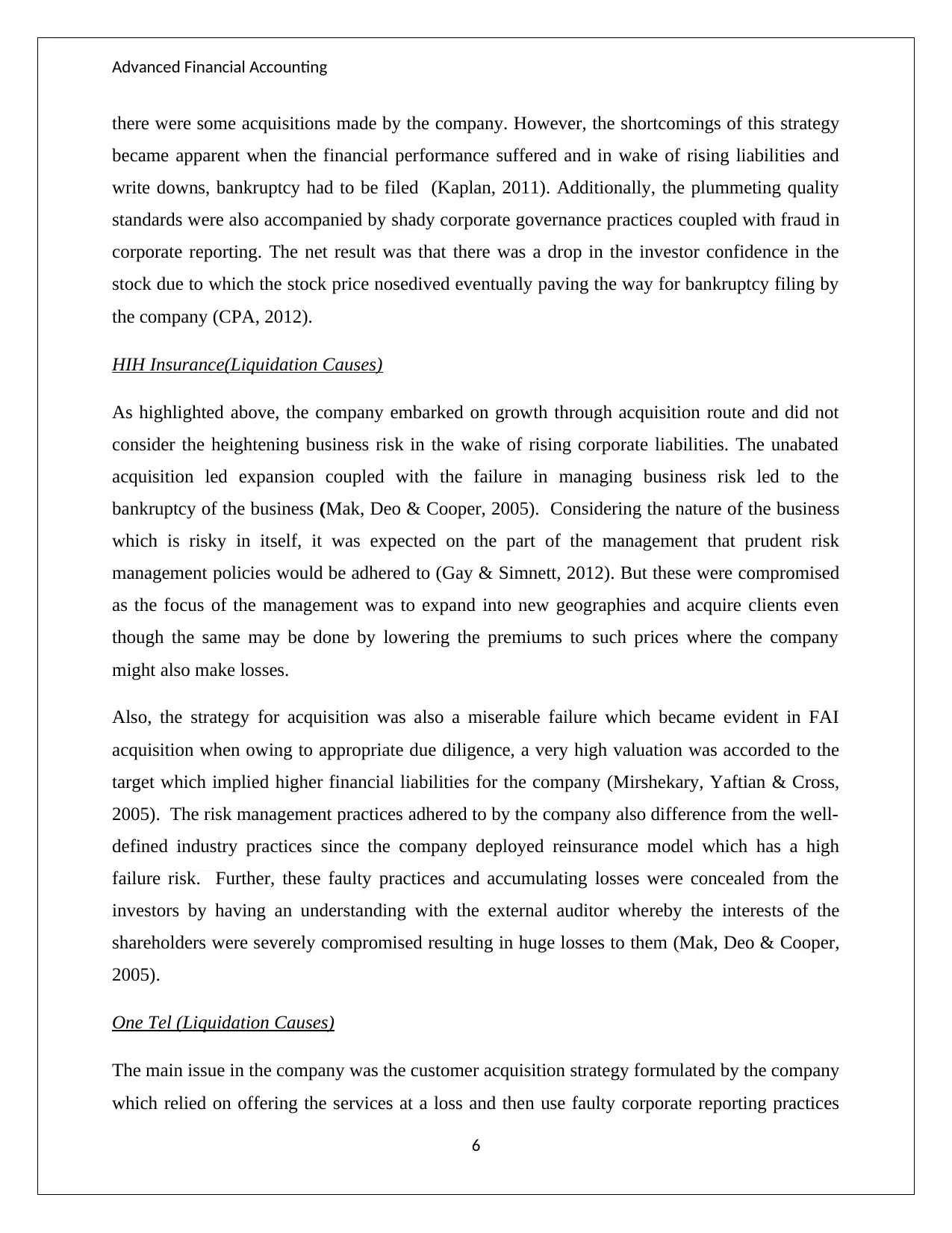
Advanced Financial Accounting
there were some acquisitions made by the company. However, the shortcomings of this strategy
became apparent when the financial performance suffered and in wake of rising liabilities and
write downs, bankruptcy had to be filed (Kaplan, 2011). Additionally, the plummeting quality
standards were also accompanied by shady corporate governance practices coupled with fraud in
corporate reporting. The net result was that there was a drop in the investor confidence in the
stock due to which the stock price nosedived eventually paving the way for bankruptcy filing by
the company (CPA, 2012).
HIH Insurance(Liquidation Causes)
As highlighted above, the company embarked on growth through acquisition route and did not
consider the heightening business risk in the wake of rising corporate liabilities. The unabated
acquisition led expansion coupled with the failure in managing business risk led to the
bankruptcy of the business (Mak, Deo & Cooper, 2005). Considering the nature of the business
which is risky in itself, it was expected on the part of the management that prudent risk
management policies would be adhered to (Gay & Simnett, 2012). But these were compromised
as the focus of the management was to expand into new geographies and acquire clients even
though the same may be done by lowering the premiums to such prices where the company
might also make losses.
Also, the strategy for acquisition was also a miserable failure which became evident in FAI
acquisition when owing to appropriate due diligence, a very high valuation was accorded to the
target which implied higher financial liabilities for the company (Mirshekary, Yaftian & Cross,
2005). The risk management practices adhered to by the company also difference from the well-
defined industry practices since the company deployed reinsurance model which has a high
failure risk. Further, these faulty practices and accumulating losses were concealed from the
investors by having an understanding with the external auditor whereby the interests of the
shareholders were severely compromised resulting in huge losses to them (Mak, Deo & Cooper,
2005).
One Tel (Liquidation Causes)
The main issue in the company was the customer acquisition strategy formulated by the company
which relied on offering the services at a loss and then use faulty corporate reporting practices
6
there were some acquisitions made by the company. However, the shortcomings of this strategy
became apparent when the financial performance suffered and in wake of rising liabilities and
write downs, bankruptcy had to be filed (Kaplan, 2011). Additionally, the plummeting quality
standards were also accompanied by shady corporate governance practices coupled with fraud in
corporate reporting. The net result was that there was a drop in the investor confidence in the
stock due to which the stock price nosedived eventually paving the way for bankruptcy filing by
the company (CPA, 2012).
HIH Insurance(Liquidation Causes)
As highlighted above, the company embarked on growth through acquisition route and did not
consider the heightening business risk in the wake of rising corporate liabilities. The unabated
acquisition led expansion coupled with the failure in managing business risk led to the
bankruptcy of the business (Mak, Deo & Cooper, 2005). Considering the nature of the business
which is risky in itself, it was expected on the part of the management that prudent risk
management policies would be adhered to (Gay & Simnett, 2012). But these were compromised
as the focus of the management was to expand into new geographies and acquire clients even
though the same may be done by lowering the premiums to such prices where the company
might also make losses.
Also, the strategy for acquisition was also a miserable failure which became evident in FAI
acquisition when owing to appropriate due diligence, a very high valuation was accorded to the
target which implied higher financial liabilities for the company (Mirshekary, Yaftian & Cross,
2005). The risk management practices adhered to by the company also difference from the well-
defined industry practices since the company deployed reinsurance model which has a high
failure risk. Further, these faulty practices and accumulating losses were concealed from the
investors by having an understanding with the external auditor whereby the interests of the
shareholders were severely compromised resulting in huge losses to them (Mak, Deo & Cooper,
2005).
One Tel (Liquidation Causes)
The main issue in the company was the customer acquisition strategy formulated by the company
which relied on offering the services at a loss and then use faulty corporate reporting practices
6
⊘ This is a preview!⊘
Do you want full access?
Subscribe today to unlock all pages.

Trusted by 1+ million students worldwide
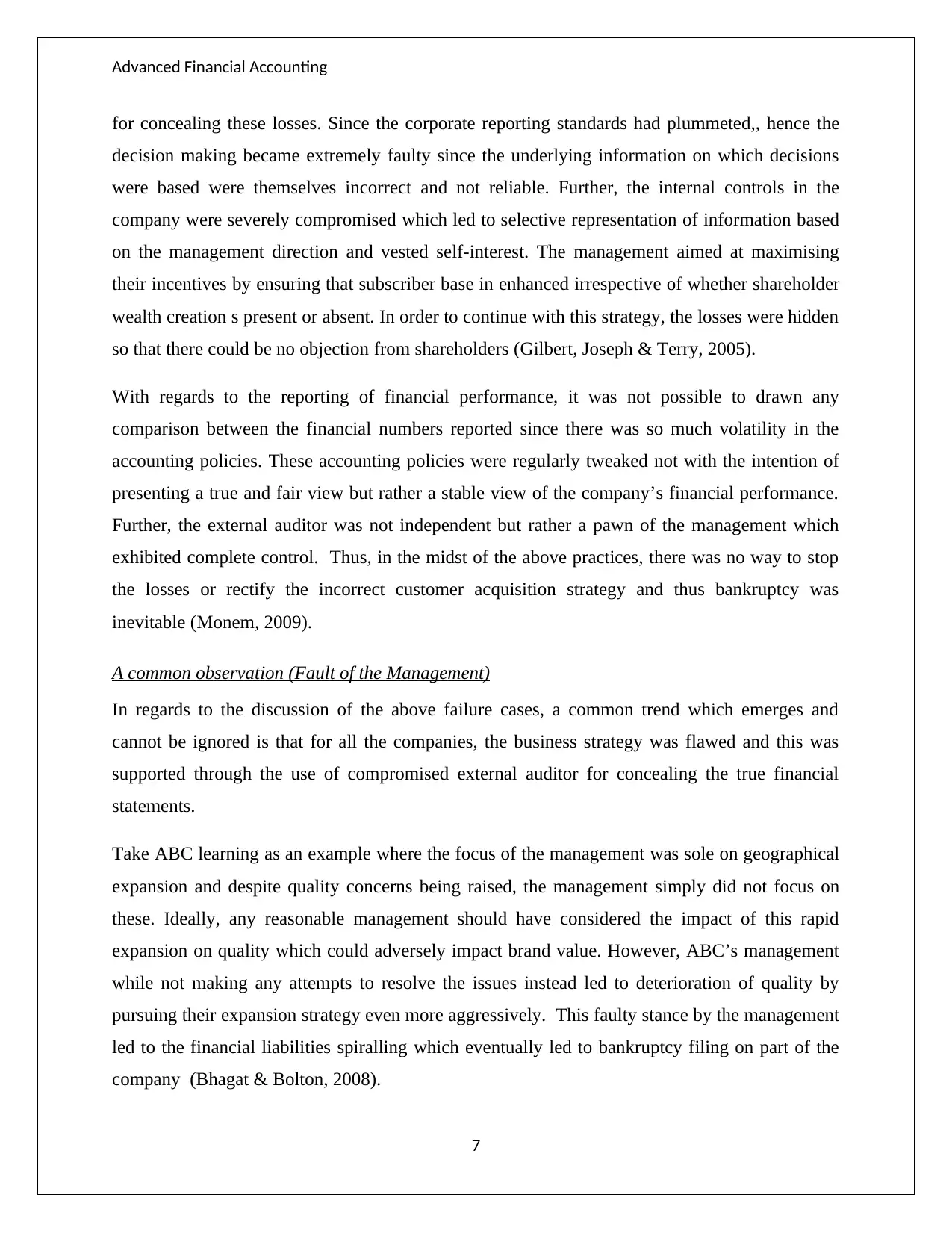
Advanced Financial Accounting
for concealing these losses. Since the corporate reporting standards had plummeted,, hence the
decision making became extremely faulty since the underlying information on which decisions
were based were themselves incorrect and not reliable. Further, the internal controls in the
company were severely compromised which led to selective representation of information based
on the management direction and vested self-interest. The management aimed at maximising
their incentives by ensuring that subscriber base in enhanced irrespective of whether shareholder
wealth creation s present or absent. In order to continue with this strategy, the losses were hidden
so that there could be no objection from shareholders (Gilbert, Joseph & Terry, 2005).
With regards to the reporting of financial performance, it was not possible to drawn any
comparison between the financial numbers reported since there was so much volatility in the
accounting policies. These accounting policies were regularly tweaked not with the intention of
presenting a true and fair view but rather a stable view of the company’s financial performance.
Further, the external auditor was not independent but rather a pawn of the management which
exhibited complete control. Thus, in the midst of the above practices, there was no way to stop
the losses or rectify the incorrect customer acquisition strategy and thus bankruptcy was
inevitable (Monem, 2009).
A common observation (Fault of the Management)
In regards to the discussion of the above failure cases, a common trend which emerges and
cannot be ignored is that for all the companies, the business strategy was flawed and this was
supported through the use of compromised external auditor for concealing the true financial
statements.
Take ABC learning as an example where the focus of the management was sole on geographical
expansion and despite quality concerns being raised, the management simply did not focus on
these. Ideally, any reasonable management should have considered the impact of this rapid
expansion on quality which could adversely impact brand value. However, ABC’s management
while not making any attempts to resolve the issues instead led to deterioration of quality by
pursuing their expansion strategy even more aggressively. This faulty stance by the management
led to the financial liabilities spiralling which eventually led to bankruptcy filing on part of the
company (Bhagat & Bolton, 2008).
7
for concealing these losses. Since the corporate reporting standards had plummeted,, hence the
decision making became extremely faulty since the underlying information on which decisions
were based were themselves incorrect and not reliable. Further, the internal controls in the
company were severely compromised which led to selective representation of information based
on the management direction and vested self-interest. The management aimed at maximising
their incentives by ensuring that subscriber base in enhanced irrespective of whether shareholder
wealth creation s present or absent. In order to continue with this strategy, the losses were hidden
so that there could be no objection from shareholders (Gilbert, Joseph & Terry, 2005).
With regards to the reporting of financial performance, it was not possible to drawn any
comparison between the financial numbers reported since there was so much volatility in the
accounting policies. These accounting policies were regularly tweaked not with the intention of
presenting a true and fair view but rather a stable view of the company’s financial performance.
Further, the external auditor was not independent but rather a pawn of the management which
exhibited complete control. Thus, in the midst of the above practices, there was no way to stop
the losses or rectify the incorrect customer acquisition strategy and thus bankruptcy was
inevitable (Monem, 2009).
A common observation (Fault of the Management)
In regards to the discussion of the above failure cases, a common trend which emerges and
cannot be ignored is that for all the companies, the business strategy was flawed and this was
supported through the use of compromised external auditor for concealing the true financial
statements.
Take ABC learning as an example where the focus of the management was sole on geographical
expansion and despite quality concerns being raised, the management simply did not focus on
these. Ideally, any reasonable management should have considered the impact of this rapid
expansion on quality which could adversely impact brand value. However, ABC’s management
while not making any attempts to resolve the issues instead led to deterioration of quality by
pursuing their expansion strategy even more aggressively. This faulty stance by the management
led to the financial liabilities spiralling which eventually led to bankruptcy filing on part of the
company (Bhagat & Bolton, 2008).
7
Paraphrase This Document
Need a fresh take? Get an instant paraphrase of this document with our AI Paraphraser
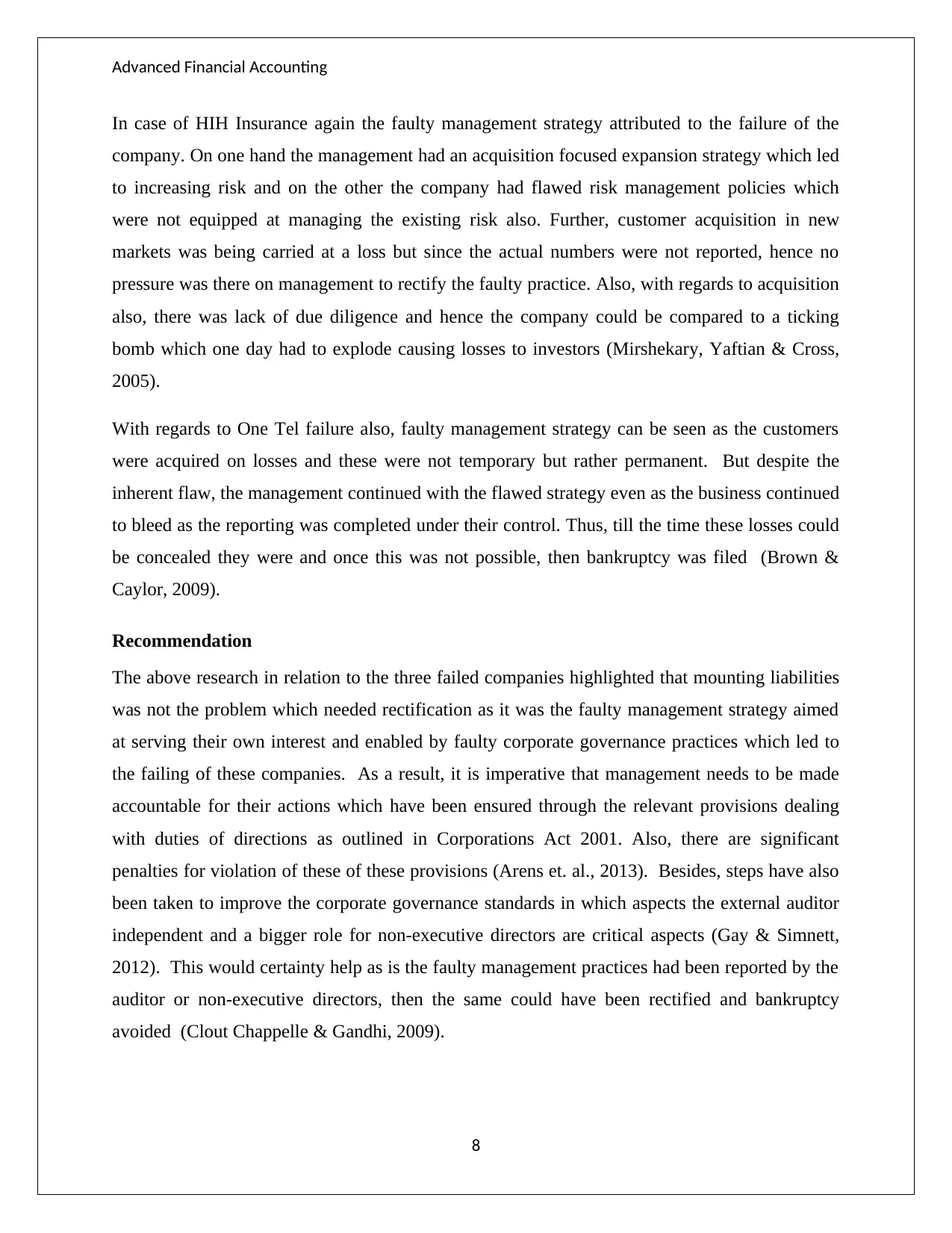
Advanced Financial Accounting
In case of HIH Insurance again the faulty management strategy attributed to the failure of the
company. On one hand the management had an acquisition focused expansion strategy which led
to increasing risk and on the other the company had flawed risk management policies which
were not equipped at managing the existing risk also. Further, customer acquisition in new
markets was being carried at a loss but since the actual numbers were not reported, hence no
pressure was there on management to rectify the faulty practice. Also, with regards to acquisition
also, there was lack of due diligence and hence the company could be compared to a ticking
bomb which one day had to explode causing losses to investors (Mirshekary, Yaftian & Cross,
2005).
With regards to One Tel failure also, faulty management strategy can be seen as the customers
were acquired on losses and these were not temporary but rather permanent. But despite the
inherent flaw, the management continued with the flawed strategy even as the business continued
to bleed as the reporting was completed under their control. Thus, till the time these losses could
be concealed they were and once this was not possible, then bankruptcy was filed (Brown &
Caylor, 2009).
Recommendation
The above research in relation to the three failed companies highlighted that mounting liabilities
was not the problem which needed rectification as it was the faulty management strategy aimed
at serving their own interest and enabled by faulty corporate governance practices which led to
the failing of these companies. As a result, it is imperative that management needs to be made
accountable for their actions which have been ensured through the relevant provisions dealing
with duties of directions as outlined in Corporations Act 2001. Also, there are significant
penalties for violation of these of these provisions (Arens et. al., 2013). Besides, steps have also
been taken to improve the corporate governance standards in which aspects the external auditor
independent and a bigger role for non-executive directors are critical aspects (Gay & Simnett,
2012). This would certainty help as is the faulty management practices had been reported by the
auditor or non-executive directors, then the same could have been rectified and bankruptcy
avoided (Clout Chappelle & Gandhi, 2009).
8
In case of HIH Insurance again the faulty management strategy attributed to the failure of the
company. On one hand the management had an acquisition focused expansion strategy which led
to increasing risk and on the other the company had flawed risk management policies which
were not equipped at managing the existing risk also. Further, customer acquisition in new
markets was being carried at a loss but since the actual numbers were not reported, hence no
pressure was there on management to rectify the faulty practice. Also, with regards to acquisition
also, there was lack of due diligence and hence the company could be compared to a ticking
bomb which one day had to explode causing losses to investors (Mirshekary, Yaftian & Cross,
2005).
With regards to One Tel failure also, faulty management strategy can be seen as the customers
were acquired on losses and these were not temporary but rather permanent. But despite the
inherent flaw, the management continued with the flawed strategy even as the business continued
to bleed as the reporting was completed under their control. Thus, till the time these losses could
be concealed they were and once this was not possible, then bankruptcy was filed (Brown &
Caylor, 2009).
Recommendation
The above research in relation to the three failed companies highlighted that mounting liabilities
was not the problem which needed rectification as it was the faulty management strategy aimed
at serving their own interest and enabled by faulty corporate governance practices which led to
the failing of these companies. As a result, it is imperative that management needs to be made
accountable for their actions which have been ensured through the relevant provisions dealing
with duties of directions as outlined in Corporations Act 2001. Also, there are significant
penalties for violation of these of these provisions (Arens et. al., 2013). Besides, steps have also
been taken to improve the corporate governance standards in which aspects the external auditor
independent and a bigger role for non-executive directors are critical aspects (Gay & Simnett,
2012). This would certainty help as is the faulty management practices had been reported by the
auditor or non-executive directors, then the same could have been rectified and bankruptcy
avoided (Clout Chappelle & Gandhi, 2009).
8
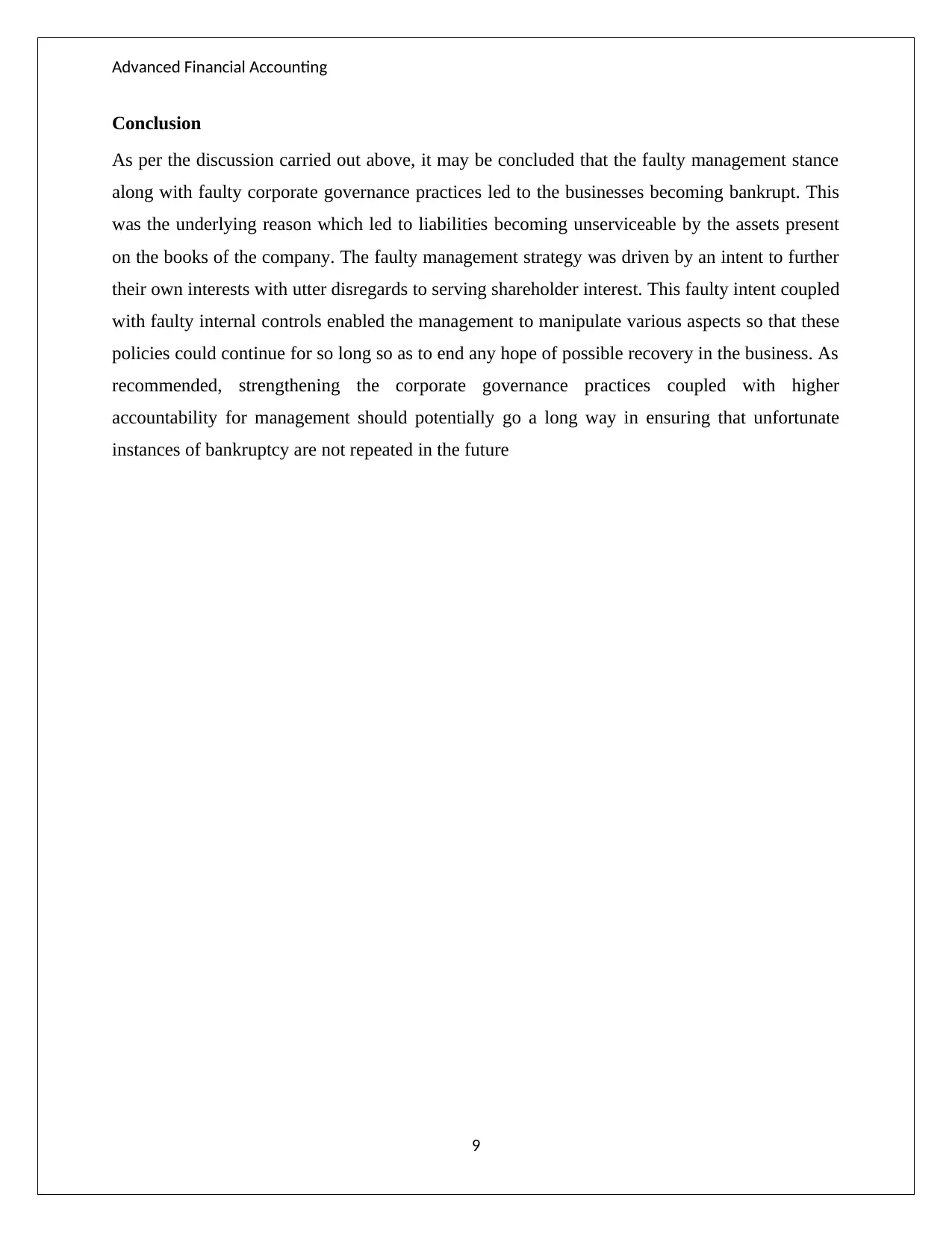
Advanced Financial Accounting
Conclusion
As per the discussion carried out above, it may be concluded that the faulty management stance
along with faulty corporate governance practices led to the businesses becoming bankrupt. This
was the underlying reason which led to liabilities becoming unserviceable by the assets present
on the books of the company. The faulty management strategy was driven by an intent to further
their own interests with utter disregards to serving shareholder interest. This faulty intent coupled
with faulty internal controls enabled the management to manipulate various aspects so that these
policies could continue for so long so as to end any hope of possible recovery in the business. As
recommended, strengthening the corporate governance practices coupled with higher
accountability for management should potentially go a long way in ensuring that unfortunate
instances of bankruptcy are not repeated in the future
9
Conclusion
As per the discussion carried out above, it may be concluded that the faulty management stance
along with faulty corporate governance practices led to the businesses becoming bankrupt. This
was the underlying reason which led to liabilities becoming unserviceable by the assets present
on the books of the company. The faulty management strategy was driven by an intent to further
their own interests with utter disregards to serving shareholder interest. This faulty intent coupled
with faulty internal controls enabled the management to manipulate various aspects so that these
policies could continue for so long so as to end any hope of possible recovery in the business. As
recommended, strengthening the corporate governance practices coupled with higher
accountability for management should potentially go a long way in ensuring that unfortunate
instances of bankruptcy are not repeated in the future
9
⊘ This is a preview!⊘
Do you want full access?
Subscribe today to unlock all pages.

Trusted by 1+ million students worldwide
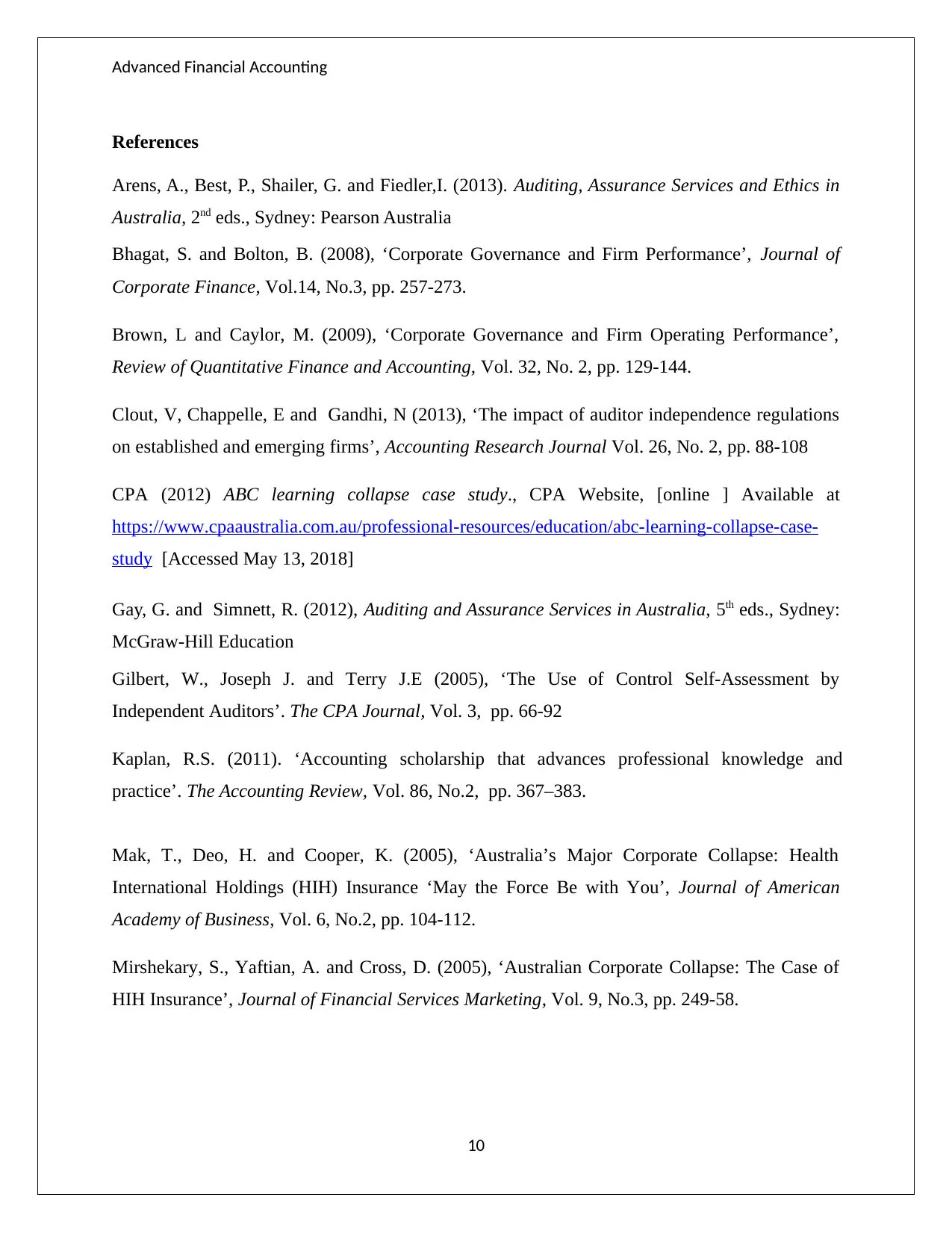
Advanced Financial Accounting
References
Arens, A., Best, P., Shailer, G. and Fiedler,I. (2013). Auditing, Assurance Services and Ethics in
Australia, 2nd eds., Sydney: Pearson Australia
Bhagat, S. and Bolton, B. (2008), ‘Corporate Governance and Firm Performance’, Journal of
Corporate Finance, Vol.14, No.3, pp. 257-273.
Brown, L and Caylor, M. (2009), ‘Corporate Governance and Firm Operating Performance’,
Review of Quantitative Finance and Accounting, Vol. 32, No. 2, pp. 129-144.
Clout, V, Chappelle, E and Gandhi, N (2013), ‘The impact of auditor independence regulations
on established and emerging firms’, Accounting Research Journal Vol. 26, No. 2, pp. 88-108
CPA (2012) ABC learning collapse case study., CPA Website, [online ] Available at
https://www.cpaaustralia.com.au/professional-resources/education/abc-learning-collapse-case-
study [Accessed May 13, 2018]
Gay, G. and Simnett, R. (2012), Auditing and Assurance Services in Australia, 5th eds., Sydney:
McGraw-Hill Education
Gilbert, W., Joseph J. and Terry J.E (2005), ‘The Use of Control Self-Assessment by
Independent Auditors’. The CPA Journal, Vol. 3, pp. 66-92
Kaplan, R.S. (2011). ‘Accounting scholarship that advances professional knowledge and
practice’. The Accounting Review, Vol. 86, No.2, pp. 367–383.
Mak, T., Deo, H. and Cooper, K. (2005), ‘Australia’s Major Corporate Collapse: Health
International Holdings (HIH) Insurance ‘May the Force Be with You’, Journal of American
Academy of Business, Vol. 6, No.2, pp. 104-112.
Mirshekary, S., Yaftian, A. and Cross, D. (2005), ‘Australian Corporate Collapse: The Case of
HIH Insurance’, Journal of Financial Services Marketing, Vol. 9, No.3, pp. 249-58.
10
References
Arens, A., Best, P., Shailer, G. and Fiedler,I. (2013). Auditing, Assurance Services and Ethics in
Australia, 2nd eds., Sydney: Pearson Australia
Bhagat, S. and Bolton, B. (2008), ‘Corporate Governance and Firm Performance’, Journal of
Corporate Finance, Vol.14, No.3, pp. 257-273.
Brown, L and Caylor, M. (2009), ‘Corporate Governance and Firm Operating Performance’,
Review of Quantitative Finance and Accounting, Vol. 32, No. 2, pp. 129-144.
Clout, V, Chappelle, E and Gandhi, N (2013), ‘The impact of auditor independence regulations
on established and emerging firms’, Accounting Research Journal Vol. 26, No. 2, pp. 88-108
CPA (2012) ABC learning collapse case study., CPA Website, [online ] Available at
https://www.cpaaustralia.com.au/professional-resources/education/abc-learning-collapse-case-
study [Accessed May 13, 2018]
Gay, G. and Simnett, R. (2012), Auditing and Assurance Services in Australia, 5th eds., Sydney:
McGraw-Hill Education
Gilbert, W., Joseph J. and Terry J.E (2005), ‘The Use of Control Self-Assessment by
Independent Auditors’. The CPA Journal, Vol. 3, pp. 66-92
Kaplan, R.S. (2011). ‘Accounting scholarship that advances professional knowledge and
practice’. The Accounting Review, Vol. 86, No.2, pp. 367–383.
Mak, T., Deo, H. and Cooper, K. (2005), ‘Australia’s Major Corporate Collapse: Health
International Holdings (HIH) Insurance ‘May the Force Be with You’, Journal of American
Academy of Business, Vol. 6, No.2, pp. 104-112.
Mirshekary, S., Yaftian, A. and Cross, D. (2005), ‘Australian Corporate Collapse: The Case of
HIH Insurance’, Journal of Financial Services Marketing, Vol. 9, No.3, pp. 249-58.
10
Paraphrase This Document
Need a fresh take? Get an instant paraphrase of this document with our AI Paraphraser
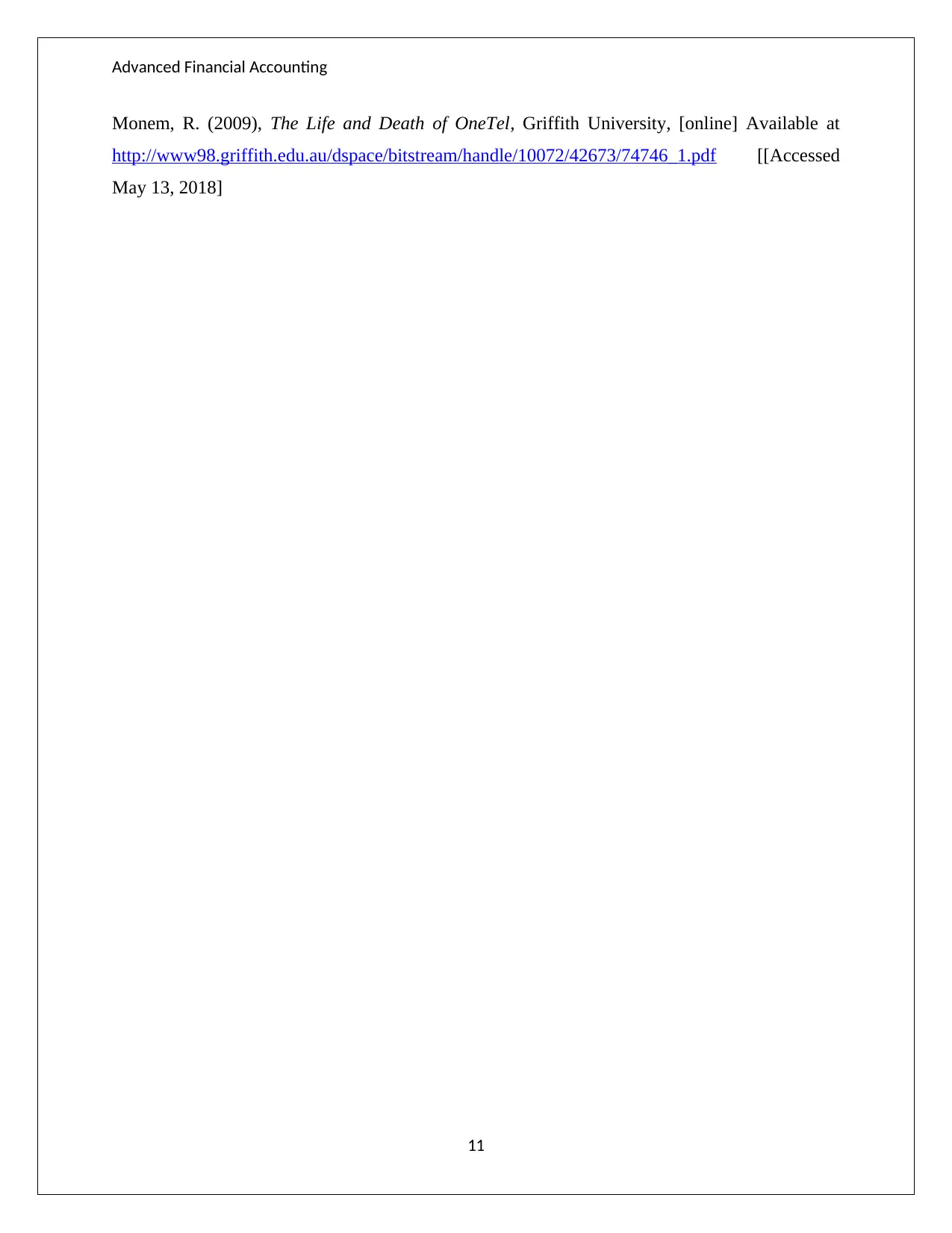
Advanced Financial Accounting
Monem, R. (2009), The Life and Death of OneTel, Griffith University, [online] Available at
http://www98.griffith.edu.au/dspace/bitstream/handle/10072/42673/74746_1.pdf [[Accessed
May 13, 2018]
11
Monem, R. (2009), The Life and Death of OneTel, Griffith University, [online] Available at
http://www98.griffith.edu.au/dspace/bitstream/handle/10072/42673/74746_1.pdf [[Accessed
May 13, 2018]
11
1 out of 11
Related Documents
Your All-in-One AI-Powered Toolkit for Academic Success.
+13062052269
info@desklib.com
Available 24*7 on WhatsApp / Email
![[object Object]](/_next/static/media/star-bottom.7253800d.svg)
Unlock your academic potential
Copyright © 2020–2025 A2Z Services. All Rights Reserved. Developed and managed by ZUCOL.





